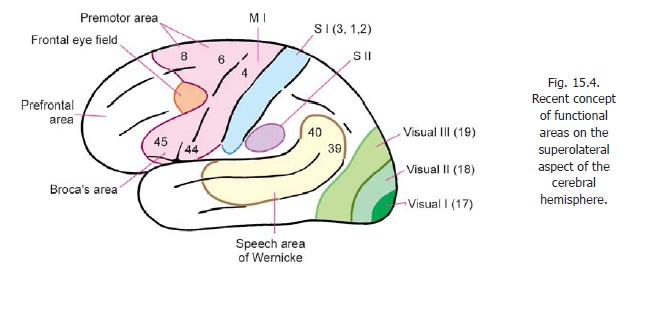Chapter: Human Neuroanatomy(Fundamental and Clinical): Further Consideration of the Cerebral Cortex
Sensory Areas of the Cerebral Cortex
Sensory Areas
The sensory area of classical description is also called the first somatosensory area (SI). It receives projections from the ventral posteromedial and ventral posterolateral nuclei of the thalamus, conveying impulses received through the medial, spinal and trigeminal lemnisci. We have seen that different parts of the body have a definite representation within this area.

Advanced:
It has also been shown that different sensations may be represented in different parts within the area. Unit recordings show that area 2 is concerned mainly with proprioceptive impulses, while area 3 responds only to cutaneous stimuli.
A second area predominantly somatosensory in function (second somatosensory area or SII) has been described in relation to the superior lip of the posterior ramus of the lateral sulcus (Fig. 15.4).
The sensory speech area of Wernicke lies in the posterior part of the superior and middle temporal gyri. It extends into areas 39 and 40 of the parietal lobe. This area is responsible for interpretation of speech.
Parts of the superior parietal lobule (areas 5, 7) help us to recognise shape, size and texture of objects
Like area SI, SII receives fibres from the ventral posterior nucleus of the thalamus. It also receives fibres from SI. Descending fibres from SII reach the spinal cord, the nucleus gracilis and cuneatus and the main trigeminal nucleus. Neurons in SII respond best to intermittent stimulation e.g., vibration. SII may be responsible for perception of pain and temperature.
A small part of the primary sensory area, probably within area 2, is believed to serve as a corticalvestibular area.
Clinical:
The effects of damage to sensory areas are as follows.
i. Damage to the first somatosensory area causes loss of sensation (both exteroceptive and prioprioceptive) from the opposite side of the body.
ii. Damage to the second sensory area may lead to inability to appreciate pain and temperature.
iii. Damage to some areas behind the main sensory area (areas 5, 7) interferes with ability to identify objects by feeling them.
iv. Damage to the area of Wernicke leads to failure to understand speech.
Related Topics